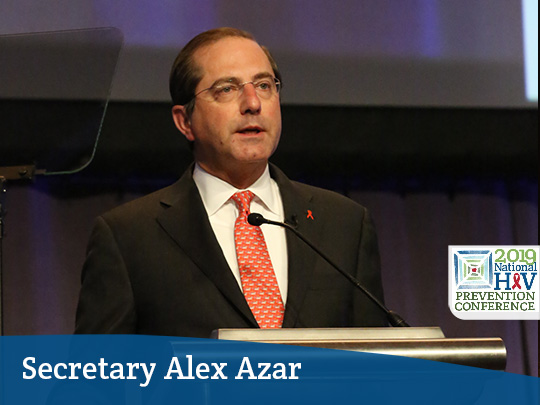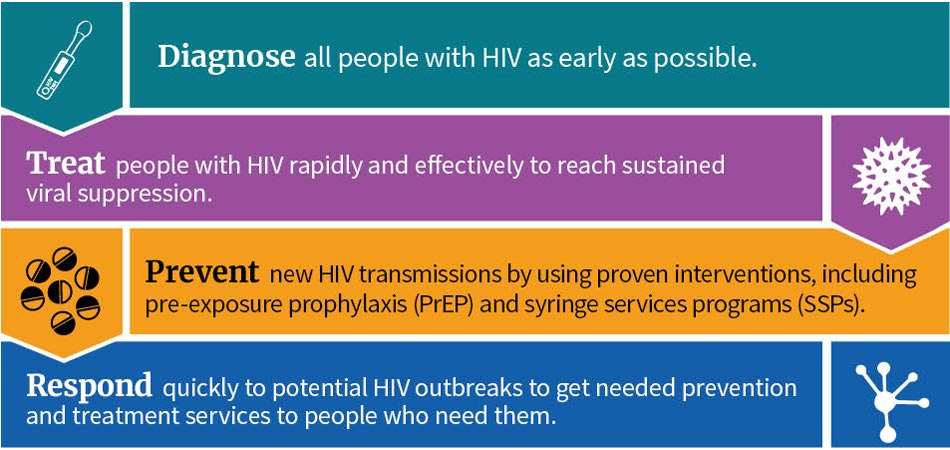Secretary Azar Addresses CDC’s National HIV Prevention Conference

The second plenary session at the CDC’s 2019 National HIV Prevention Conference featured remarks by HHS Secretary Alex Azar, thoughts on how we can get to no new HIV infections, and a conversation about PrEP. The second plenary was held Tuesday morning, March 19.
Secretary Azar on Working Together to End the HIV Epidemic in America
The featured speaker was Secretary of Health and Human Services Alex Azar, who discussed Ending the HIV Epidemic: A Plan for America, the Administration’s Plan to reduce new infections nationally by 75% in the next five years, and by at least 90% in the next ten years. The Secretary declared that today, we have the right data, the right tools, and the right leadership to end the HIV epidemic.
This Plan is built around data, he noted, reviewing data about the geographic and demographic concentration of new HIV infections in the United States. He also observed that new HIV infections are also disproportionately concentrated in places where socio-economic and cultural barriers to treatment and prevention remain high, including the South. That data informed the selection of the 48 counties, San Juan, DC, and seven rural states where new resources will be focused in the first phase of the initiative.
That data will help make best use of the biomedical, programmatic, and public health tools we have available today. The initiative will focus on using those tools to diagnose, treat, protect, and respond (see graphic).

Secretary Azar discussed each of the four pillars of the initiative and highlighted steps that HHS would take to support implementation. He also highlighted new investments proposed in the President’s FY2020 budget to support the initiative. Secretary Azar also mentioned that the Food and Drug Administration, a part of HHS, had just announced new guidance to support development of prescription drugs for HIV. One is for pediatric HIV infections [PDF, 71KB], and the other is for the development of new forms of pre-exposure prophylaxis, or PrEP [PDF, 91KB], with a special focus on long-acting formulations.
Finally, he highlighted the Administration’s commitment to this Initiative and promised that the execution of the plan to end the HIV epidemic in the U.S. will be a top priority for his entire tenure as Secretary. He recognized new members from the Presidential Advisory Council on HIV/AIDS (PACHA) that were in attendance at the conference and highlighted their important role in advising on this effort. Last, but certainly not least, the Secretary emphasized that the leadership of all of those attending the conference and many others working on the frontlines of the HIV response in communities across the country would be vital to the success of the Plan.
Read Secretary Azar’s full remarks.
CDC’s Dr. McCray on Specific Actions Needed to Get to No New HIV Infections

Dr. Eugene McCray, Director of CDC’s Division of HIV/AIDS Prevention, discussed the demographic and geographic statistics that support the need for a focused effort such as the new Ending the HIV Epidemic initiative.
Dr. McCray highlighted populations in need of focused efforts, underutilized tools, and missed opportunities that could be addressed, noting that:
- While 1 in 7 people with HIV in the U.S. are unaware of their infection, it is younger people who are more likely to not know their HIV status. Many more HIV infections could be prevented—especially among gay, bisexual, and other men who have sex with men (MSM) and people who inject drugs—if HIV testing was offered more frequently in clinical settings.
- Syringe services programs (SSPs) can play a vital role in preventing HIV and other health problems among people who inject drugs, but we know that SSPs are not in places where they are needed most.
- New HIV infections are increasing among young Black and Latino MSM, an alarming and a clear signal that our work is nowhere near done.
- Diagnosis delays are too common; one half of people who received an HIV diagnosis in 2015 had been living with HIV for three years or more.
- Cluster detection can identify more individuals affected by an HIV outbreak and link them to appropriate testing, prevention, and care services.
Dr. McCray underscored his belief that, working together, we can achieve the goals of reducing new infections by 75% in five years and by 90% in ten years.
PrEP Debate
The plenary session also featured a mock debate over PrEP, examining some of the various issues involved in increasing awareness and uptake of this HIV prevention tool among populations at high risk for HIV infection. Dr. Judith Aberg of the Icahn School of Medicine at Mount Sinai squared off against Dr. Michael Saag of the University of Alabama at Birmingham School of Medicine, in the debate moderated by Dázon Dixon Diallo of Atlanta’s SisterLove. After the presenters examined issues including adherence, STIs, and price, Ms. Diallo summed up the “argument,” noting that the debaters – as well as much of the audience – agreed that PrEP is a critical tool in our response to HIV, and that we must work together to identify and implement the best ways to make it accessible to those who need it.
Interested in viewing all or part of the plenary session? CDC’s National Prevention Information Network has the video on their Facebook pageExit Disclaimer.